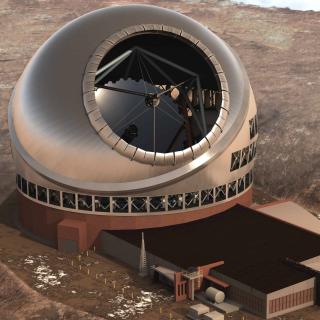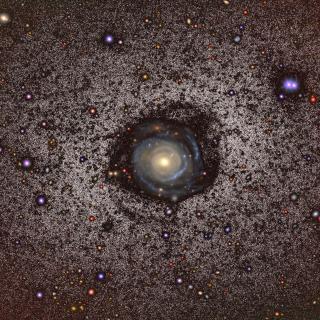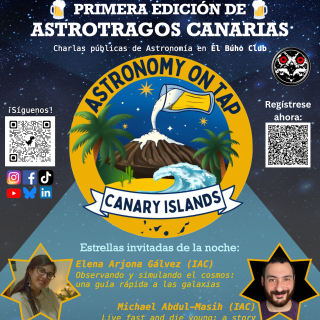HTRA studies phenomena that change very quickly in time, on timescale of second or millisecond, that occur mainly near compact objects such as neutron stars or black holes. It requires using instrumentation capable of taking images of the sky at great speed. According to Tariq Shahbaz, a researcher at the IAC and one of the organisers of the latest edition of the Winter School: "HTRA offers the possibility to advance the understanding of certain astrophysical and physical processes, especially those related to extreme gravity near neutron stars and stellar mass black holes. It also allows us to study planetary transits, that provides us with the basic parameters of exoplanets."
Seven international scientists especially related to the High Time Resolution Astrophysics (HTRA) will be teaching at this twenty-seventh edition of the School. For two weeks, around thirty doctoral and post-doctoral students, from more than twenty different countries, will take an in-depth look at research that is tightly linked with state-of-the art technology. This innovative approach concerns different areas of astrophysics, which are testing the new time domain of high resolution.
This initiative aims to promote exchange between the lecturers and the students, the latter will play an active role in the School by presenting their own research, participating in discussion groups and attending several group activities. They will visit the headquarters of the IAC on the 10th November, San Cristóbal de La Laguna (World Heritage Site) on the 12th and the Observatorio del Teide (OT) on the 18th. As in previous years a book containing the material from the School will be published by Cambridge University Press
Professor Tomaso Belloni of the Osservatorio Astronomico di Brera (Italy) will also give a public lecture on `Exploring black holes with a clock´ at the Museo de la Ciencia y el Cosmos in La Laguna on Friday 13th November at 7.00 pm. The lecture will be in English with simultaneous translation into Spanish.
The XXVII Canary Islands Astrophysics Winter School is organised by the IAC with support from the Excmo. Ayuntamiento de San Cristóbal de La Laguna and the Cabildo Insular de Tenerife.
High Time Resolution Astrophysics (HTRA), hand in hand with technology
High Time resolution Astrophysics (HTRA) has opened a new window on our understanding of the universe. Normally in astrophysics we talk of a “new window” when we find a way to observe in a wavelength range previously inaccessible. But for HTRA the revolution is caused by our ability to analyze phenomena which occur at high speed, and can be observed only with high time resolution, of seconds or even milliseconds
What are the phenomena that produce information that can be revealed only on such short time scales? Generally they are violent phenomena that present extreme rapid variations, such as those related to the very rapid rotation of a plasma, its interaction with magnetic fields, the ejection of jets of gas at relativistic velocities, or the collision of stellar winds. Many of these processes occur close to very compact objects such as black holes or neutron stars. But also the transit of an extrasolar planet across the edge of its star or the eclipse of a star by a transneptunian object. From this type of observations we are able not only to analyze the physics of the violent universe, but also to measure the sizes of very small objects such as planets or asteroids.
HTRA has been related, historically, to high energy radiation, that is radiation generated by very “hot” material (x-rays, gamma-rays….). The arrival of HTRA to observe at lower energies is related directly to advances in technology. For example fifteen years ago it was impossible to study with CCDs optical phenomena that last less than ten seconds. CCD cameras, similar to our photographic cameras, took a long time to read-out the whole array, which meant that its time resolution was very limited. The use of newer technology has allowed us to provide CCD cameras with a rapid readout, low-noise mode, thus opening the window on the optical and infrared universe to time resolution well below one second.
For example the high velocity camera ULTRACAM, developed by Vik Dhillon, a lecturer at the XXVII Canary Islands Winter School of Astrophysics, works at a time resolution of hundredths of a second and can take optical images in three colours. It has been used as a visiting instrument on the William Herschel Telescope (WHT) in La Palma and on the NTT (New Technology Telescope) and the VLT (Very Large Telescope) in Chile. There is an improved version of ULTRACAM, HiPERCAM, which can reach milliseconds simultaneously in five colours. This allows us to see rapid changes in different bands over short times, and so study the “colour variability”. This way one can obtain very detailed information about the temperature and the physical characteristics of the material that gives rise to this variation. This is a great step forward compared to past technology. In a couple of years it is planned to be installed it on the Gran Telescopio CANARIAS (GTC), which will, in the words of Dhillon “make it the most powerful telescope in the world for HTRA in the optical part of the spectrum”.
Lecturers and topics:
Julian Malzac, University of Toulouse, France: Radiation Processes and models.
Andrea Possenti, Astronomical Observatory of Cagliari, Italy: Radio observations of pulsars and X-ray binary systems.
Danny Steeghs, University of Warwick, UK: Optical observations of stellar and non-stellar objects.
Tomaso Belloni, Osservatorio Astronomico di Brera, Italy: X-ray observations of X-ray binaries and AGN, and Timing analysis.
Phil Charles, University of Southampton, UK: Instrumentation - I
Vik Dhillon, University of Sheffield, UK: Instrumentation - II
Elizabeth Ferrara, NASA Goddard Space Flight Center, and University of Maryland, College Park, USA: Gamma-ray Observations of X-ray binaries
Organizing Committee
Tariq Shahbaz
Jorge Casares
Teodoro Muñoz Darias
Antonio Aparcio
Rafael Rebolo
Press Room
Press releases, interviews and general information about the School will be published here.
Press contact:
Annia Domènech
annia [at] iac.es (annia[at]iac[dot]es)
(0034) 922605227
(0034) 638793788
Winter Schools



